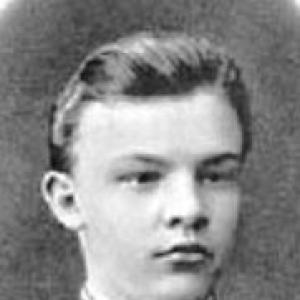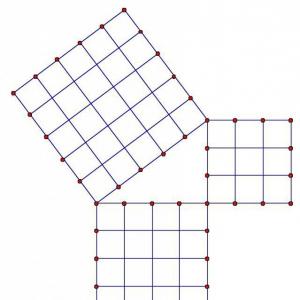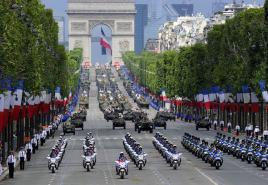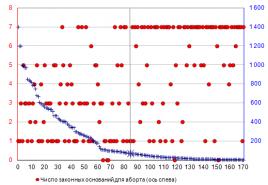Medal "XX Years of the Workers' and Peasants' Red Army" The award system of the Soviet army How many medals of the Second World War
Briefly: Jubilee medal, pendant on a rectangular block, no bars, no degrees.


Before the Great Patriotic War award system of the USSR included a fairly small number of orders and medals, and the awards themselves were rare, so there was no problem of placing them on the chest. All orders and medals were worn on the left side of the chest.

Viktor Talalikhin before the war

Vasily Konstantinovich Blucher
The first three years of Soviet power were treated with a single award - the Order for participation in the battles of the Red Banner. Only in 1920 did it become necessary to celebrate citizens for hard work and another Order of the Red Banner of Labor was established. After that, for a long 10 years, there were no reasons to increase the list of awards.
Order of the Red Banner
The only change in the military order was the replacement in 1925 of the inscription "RSFSR" with "USSR". Moreover, a complete replacement of the badge was originally planned, and at the end of 1924 a competition was announced to create a project for the badge of the order. However, the commission, having considered 683 sketches from 393 authors, did not approve any of them, since all of them were inferior to the drawing of the Order of the Red Banner of the RSFSR. Therefore, it was decided to leave it as the initial one for creating a new sign.

Change of the Order of the Red Banner in 1925
The first labor award of the USSR
The Order of the Red Banner of Labor had a few more changes. Initially, the republics had their own, republican varieties of the order, but after the creation of the USSR in 1922, it became necessary to develop a single award and in 1928 a new sign appeared, the so-called "Triangle", and in 1936 the form of the order was once again radically redesigned. In this form, the sign lasted until 1991.

Changes in the Order of the Red Banner of Labor
Order of the Red Star
In 1929, there was a conflict on the Chinese Eastern Railway. During the fighting, the Red Army defeated parts of the Kuomintang, restoring the status of the road. It is possible that in connection with this event, the Soviet leadership thought about increasing the number of military awards, after which, in 1930, the Order of the Red Star appears. The first holder of the Order of the Red Star was the commander of the Special Red Banner Far Eastern Army V.K. Blucher.

The order of Lenin
In the same year, the country celebrated the 60th anniversary of the birth of V.I. Lenin. To commemorate the anniversary, on April 6, 1930, simultaneously with the Order of the Red Star, the Order of Lenin was established. With several changes in appearance, it was the highest award of the Soviet Union until 1991.

Change of the Order of Lenin in 1934

Hero of the Soviet Union Senior Lieutenant Anatoly Vasilyevich Samochkin
There is an erroneous opinion that the Hero medal is the highest award of the USSR, however, this is not so. Hero of the Soviet Union is not an award, it is a title. First established on April 16, 1934, the title of Hero did not have any insignia at all, and only a diploma of the Central Executive Committee of the USSR was awarded to the cavalier. Each Hero was awarded the Order of Lenin. Only four years later, on August 1, 1939, the insignia of the Hero of the Soviet Union, the Gold Star medal, was established.
Another order for rewarding labor achievements was established by the Decree of the Central Executive Committee of the USSR on November 25, 1935 - "Badge of Honor". He became the most common of the orders and was awarded not only for peaceful achievements. In December 1941, the Order of the Badge of Honor was awarded to a group of commanders of the Red Army, employees of state security agencies and civilians who distinguished themselves in the defense of Odessa. And in 1942, this order was awarded to 170 partisans, among whom was the commissar of the partisan unit Kovpak Rudnev S.V.
The Order of the Badge of Honor was also awarded to children for success in work and study. Thus, a student of School No. 3 in Tbilisi, Eteri Gvantseladze, received the Order of the Badge of Honor for excellent studies and active social work.

Establishment of the first medals of the USSR
As we can see, in the new award system of the Soviet country there were only five orders and until 1938 there was not a single medal. The first reason for the mass awarding of military personnel was the 20th anniversary of the Workers 'and Peasants' Red Army and the Navy. Orders for such purposes were not entirely suitable, and on January 24, 1938, the Presidium of the Supreme Soviet of the USSR established the first medal in the history of the Soviet country "XX years of the Red Army".

The year 1938 became abundant for new medals. In autumn, October 17, the Presidium of the Supreme Council established two more military medals - "For Courage" and "For Military Merit". They were worn on a small rectangular block, of the same type with other medals, and even a scarlet ribbon was used for all.
And on December 27, 1938, two labor medals were established: "For Valiant Labor" and "For Labor Distinction". For them, new triangular-shaped pads were developed.


Sanitary instructor of the 369th separate battalion of marines of the Danube military flotilla chief foreman Ekaterina Illarionovna Mikhailova (Demina)
This completed the formation of the pre-war Soviet award system, and until 1942 not a single new award appeared.
The Great Patriotic War.
The first year of the war was so difficult for the Soviet Union, associated with a long retreat, countless local defeats and huge losses, that awards were a very rare event. The situation was aggravated by the confusion that was going on in the retreating units. Nevertheless, the mass feat of the Soviet soldier could not be ignored, and already in the spring of 1942, the Presidium of the Supreme Council established the Order of the Patriotic War, which became the first award in modern history that has two degrees. Also, this order differed from the previous ones in that its statute detailed the feats for which the military personnel were presented for the award (For example: Who shot down in an air battle, being part of the crew of a fighter aircraft - 3 aircraft).

Order of the Patriotic War
Orders for commanders
The summer of 1942 did not bring significant success, but the Red Army was no longer the same as a year ago - brilliant military operations were carried out in certain sectors of the front, partisan detachments became more active in the rear. Even in winter, there was a radical turning point in the war after the first major offensive of Soviet troops near Moscow, the advance of German troops was stopped, in Stalingrad the vaunted Nazi army got bogged down in urban battles and could not even reach the Volga. There was a need to encourage the senior command staff who developed these operations and the Supreme Council decides to establish three so-called "commander" orders at once, bearing the names of the great Russian military leaders: the Order of Suvorov, the Order of Kutuzov and the Order of Alexander Nevsky. The Decree of the PVS of the USSR of July 29, 1942 established three degrees for the orders of Suvorov and Kutuzov. If these two orders were awarded only to the highest command staff, then the Order of Alexander Nevsky was more democratic - it was awarded starting from platoon commanders, squadrons in aviation.

Orders of Suvorov, Kutuzov and Alexander Nevsky until 1943

Squadron Commander of the 6th Separate Guards Assault Aviation Regiment Captain Ivan Aleksandrovich Musienko
Medals for the defense of cities
In November 1942, the largest military operation "Uranus", developed by G.K. Zhukov. Literally in four days, from November 19 to 23, having crushed the Nazi defenses, the Red Army surrounded 22 German divisions and defended Stalingrad. To commemorate this grand event, the Presidium of the Supreme Soviet of the USSR decided to commemorate the exploits of the defenders of cities and, by Decree of December 22, 1942, establishes four medals at once: "For the Defense of Leningrad", "For the Defense of Odessa", "For the Defense of Sevastopol" and "For the Defense of Stalingrad" .

This Decree is of great historical importance because it was thanks to it that Soviet awards acquired a pentagonal block, ribbons of individual colors and took on a finished look that was preserved throughout the existence of the Soviet Union, then transferred to the award system of the new Russia.
Changes to the reward system
On June 19, 1943, the Decree of the Presidium of the Supreme Soviet of the USSR “On approval of samples and descriptions of ribbons for orders and medals of the USSR and the rules for wearing orders, medals, order ribbons and insignia” was issued, which radically changed the appearance of all awards and streamlined the rules for wearing orders and medals.
The red moire ribbon completely disappeared from the blocks of orders and medals, remaining only on the highest insignia - the Star of the Hero of the Soviet Union. Almost all the orders that had a screw fastening received pentagonal blocks, ribbons of individual colors and, according to paragraph 2 of the Rules for wearing orders, medals, were worn on the left side, along with medals.

It was decided not to make orders having the shape of a star on the blocks. For this reason, the Order of the Red Star was the only one left unchanged. An exception, subsequently, was made only for the Order of Glory. All awards without a block are supposed to be worn on the right side of the chest.

For all pre-war medals, rectangular pads were replaced with pentagonal ones, similar to the orders and pads of the medals "For Defense" with ribbons of different colors.

This ended the reform and the award system of the USSR took the form in which it has survived to this day. All modern awards are located on the chest according to the expanded Rules, the basis of which was laid on June 19, 1943.
However, one should not think that after the issuance of this Decree, the awards were immediately replaced with samples of a new type. Front-line soldiers freely, without any problems, wore awards received before 1943 along with new ones, there were no strict orders for replacement.

Amet-Khan Sultan - Soviet military ace pilot, Hero of the Soviet Union
Vasily Filippovich Margelov, founder of the Airborne Forces
The only time when every single award was replaced with new ones was the Victory Parade on June 24, 1945 on Red Square. All participants received brand new, directly from the Mint, orders and medals.

Tankers, participants in the Victory Parade in 1945
The award system of the Soviet Army is presented as of 1988. It differs from the previous ones only in that it includes awards that appeared after 1970 and the arrangement of awards has been slightly changed (horizontally instead of obliquely). In general, it has changed little since the Great Patriotic War.

It should be noted:
1. In the USSR, the awards included only those insignia that were established by the Supreme Council (SC) of the USSR and which are awarded by the Decree of the Presidium of the USSR Armed Forces or by orders of certain ministries (MO, MVD, KGB), on behalf of the USSR Armed Forces.
2. Awards are divided into orders and medals. An order is considered a higher award than a medal and the awarding of the order is made only by the Decree of the Presidium of the USSR Armed Forces on the basis of individual applications submitted to the person to be awarded (Award sheet, Submission). Most medals are awarded by Decree of the Presidium of the USSR Armed Forces or by order of some ministries (MO, MVD, KGB) on the basis of the lists submitted to the USSR Armed Forces.
3. Many orders can be awarded not only to people, but also to organizations, cities, regions, republics.
Medals are awarded only to people. The nationality of the person being awarded does not matter.
4. The statute of each award defines the feats or merits for which a person can be awarded one or another award, and many of the awards can be conditionally divided into military (combat) and civilian. The main criterion is the accomplishment of a feat by a person or his merit. Although, in order to be eligible for some awards, you must be a soldier, hold a certain position, have a certain rank, be in military service for a certain period.
5. If the award has several degrees, then some of them can only be awarded sequentially, starting with the lowest and no more than one award of each degree.
Awards with two or three degrees are not awarded sequentially, but depending on the position held.
This primarily concerns the orders of Suvorov, Bogdan Khmelnitsky, Kutuzov.
If the award does not have degrees, then the same award can be awarded several times. This mainly applies to orders. Most medals can only be awarded once.
6. There are two types of orders - worn on a block (1) and worn without a block (2). Medals, all have pads (3).

The block is a pentagonal metal plate covered with a fabric ribbon in the colors assigned to this award. At the bottom of the block there is a hole through which a ring is threaded, to which the award is suspended. On the reverse side, the block has a pin for attaching the award to clothing. Individual medals may have a block of a different shape.
7. Instead of the awards themselves, you can wear the so-called "award strips".

When to wear the awards themselves, and when to wear the straps and whether to wear them at all, the recipient decides on civilian clothes, and wearing on military uniform is strictly regulated.
8. All awards are distributed according to their seniority. The seniority of the award is determined in its statute. The higher the deeds or merits of the recipient, the higher the reward he can be encouraged.
As of 1988, the seniority of the awards was as follows (the oldest award is at the top of the list, the youngest at the bottom. Only some images shown):
1. Order of Lenin;

2. Order of the October Revolution;
3. Order of the Red Banner;

4. Order of Suvorov, I degree

5. Order of Ushakov, I degree;

6. Order of Kutuzov I degree;

7. Order of Nakhimov, I degree;

8. Order of Bohdan Khmelnitsky, 1st class;

9. Order of Suvorov II degree;
10. Order of Ushakov II degree;
11. Order of Kutuzov II degree;
12. Order of Nakhimov II degree;
13. Order of Bogdan Khmelnitsky II degree;
14. Order of Suvorov III degree;
15. Order of Kutuzov III degree;
16. Order of Bohdan Khmelnitsky III degree
17. Order of Alexander Nevsky;

18. Order of the Patriotic War, 1st class

19. Order of the Patriotic War II degree;
20. Order of the Red Banner of Labor;
21. Order of Friendship of Peoples;
22. Order of the Red Star;

23. Order "For Service to the Homeland in the Armed Forces of the USSR", 1st class;
24. Order "For Service to the Motherland in the Armed Forces of the 2SSR" II degree;
25. Order "For Service to the Motherland in the Armed Forces of the 2SSR" III degree;
26. Order of Honor;
27. Order "For personal courage";
28. Order of Glory, 1st class;

29. Order of Glory II degree;
30. Order of Glory III degree;
31. Order of Labor Glory, 1st class
32. Order of Labor Glory II degree;
33. Order of Labor Glory III degree;
34. Medal "For Courage";

35. Ushakov medal;
36. Medal "For Military Merit";
37. Nakhimov medal;
38. Medal "For labor prowess";
39. Medal "For labor distinction";
40. Medal "For Valiant Labor (For Military Valor). In Commemoration of the 100th Anniversary of the Birth of Vladimir Ilyich Lenin";
41. Medal "Partisan of the Patriotic War" I degree;
42. Medal "Partisan of the Patriotic War" II degree;
43. Medal "For distinction in the protection of the state border of the USSR";
44. Medal "For Distinction in Military Service", 1st class;
45. Medal "For Distinction in Military Service", II degree;
46. Medal "For excellent service in the protection of public order";
47. Medal "For courage in a fire";
48. Medal "For saving the drowning";
49. Medal "For the Defense of Leningrad";
50. Medal "For the Defense of Moscow";
51. Medal "For the Defense of Odessa";
52. Medal "For the Defense of Sevastopol";
53. Medal "For the Defense of Stalingrad";
54. Medal "For the Defense of Kyiv";
55. Medal "For the Defense of the Caucasus";
56. Medal "For the defense of the Soviet Arctic";
57. Medal "For the victory over Germany in the Great Patriotic War of 1941-1945";
58. Medal "Twenty Years of Victory in the Great Patriotic War of 1941-1945";
59. Medal "Thirty Years of Victory in the Great Patriotic War of 1941-1945";
60. Medal "Forty Years of Victory in the Great Patriotic War of 1941-1945"; 61. medal "For the victory over Japan";
62. Medal "For the capture of Budapest";
63. Medal "For the Capture of Koenigsberg";
64. Medal "For the Capture of Vienna"
65. Medal "For the Capture of Berlin";
66. Medal "For the liberation of Belgrade";
67. Medal "For the liberation of Warsaw";
68. Medal "For the liberation of Prague";
69. Medal "For Valiant Labor in the Great Patriotic War of 1941-1945";
70. Medal "Veteran of Labor";
71. Medal "Veteran of the Armed Forces of the USSR";
72. Medal "For Strengthening the Combat Commonwealth";
73. Medal "For the restoration of ferrous metallurgy enterprises of the South";
74. Medal "For the restoration of coal mines in Donbass";
75. Medal "For the development of virgin lands";
76. Medal "For the construction of the Baikal-Amur Mainline";
77. Medal "For the transformation of the Non-Chernozem region of the RSFSR";
78. Medal "For the development of subsoil and the development of the oil and gas complex of Western Siberia";
79. Medal "XX years of the Red Army";
80. Medal "30 years of the Soviet Army and";
81. Medal "40 years of the Armed Forces of the USSR";
82. Medal "50 years of the Armed Forces of the USSR";
83. Medal "60 years of the Armed Forces of the USSR";
84. Medal "70 years of the Armed Forces of the USSR";
85. Medal "50 years of the Soviet police";
86. Medal "In memory of the 800th anniversary of Moscow";
87. Medal "In memory of the 250th anniversary of Leningrad";
88. Medal "In memory of the 1500th anniversary of Kyiv";
89. Medal "For Impeccable Service", 1st class;
90. Medal "For Impeccable Service" II degree;
91. Medal "For Impeccable Service" III degree.
Issues of wearing awards, the procedure for placing them on military clothing were strictly regulated by Section V of the Rules for Wearing Military Uniforms by the Servicemen of the Soviet Army and Navy, approved by order of the USSR Ministry of Defense No. 250 of March 4, 1988. This section is called "Wearing orders, medals of the USSR, order ribbons and ribbons of medals on slats and other insignia on military uniforms."

The figure shows the placement of awards worn on blocks on a double-breasted uniform (1) (generals and naval officers), on a single-breasted officer's uniform (2), on a soldier's uniform (3) and a sailor's uniform (4). Badges that are not awards are shown in grey.
Foreign awards are worn lower than Soviet ones, which is clearly seen on the double-breasted uniform (1). On the left side of the chest, those foreign awards are worn that have something like blocks or are hung on ribbons. There are no restrictions on wearing foreign awards. They can be worn even if the soldier does not have any Soviet awards, or they do not meet Soviet standards. No permits are required to wear foreign awards.
The figure shows the placement of awards on the right side of the chest. Breastplates, in addition to those listed above, are worn below the orders, and if the soldier does not have such orders, then the badges are worn in place of the orders. Foreign awards that do not have blocks or ribbons are also worn on the right side of the chest below the Soviet orders, but above the badges.

The figure shows the placement of the straps on a double-breasted tunic (generals and naval officers) (1), on an officer's tunic (2), on a closed naval tunic (3), on a sailor's uniform (4) and on a closed everyday soldier's tunic (5).

The Soviet award system was not without flaws:
Should have been worn All awards, which sometimes turned the order bearer into a real "iconostasis";
- the establishment of medals, with which it was not known who and for what to award (800 years of Moscow, 250 years of Leningrad, 1500 years of Kyiv, 100 years since the birth of Lenin);
-replacement by Khrushchev of awarding servicemen for long service with orders for the medal "For Impeccable Service", in which the country's top leadership expressed its dismissive attitude towards hard and dangerous military labor.
The modern Russian award system is a wild, illiterate mixture of converted awards from tsarist Russia with the Soviet award system. Absolutely ridiculous in the 21st century, Old Testament order ribbons over the shoulder, orders on chains and around the neck look on modern clothes. The hasty replacement of the red ribbon with the tricolor star of the Hero, the hastily turned over medal "For Courage" and the Order of Friendship are puzzling. The award system of the new Russia turned out to be neither the recipient of the old Russian award traditions, nor a worthy successor to the Soviet traditions.
Note:
The award system of the most "democratic, freest" country in the world, the United States, is tougher on foreign awards.
The Army Manual AR 670-1 categorically determines which countries and which awards an American soldier is entitled to wear, moreover, if he does not have American awards, then he has no right to wear a single foreign award. Of course Soviet Union in this very small list of countries not specified.
And General Eisenhower put on the Soviet order "Victory" didn't have the right either..
And American pilots who ferried planes to the USSR, American sailors of polar convoys also cannot wear Soviet awards even on civilian clothes.
Combat awards of the Soviet Union (Russia, studio "Wings of Russia", 2 series) 2011
Director: Konstantin POLYAKOV
The film will tell about all the awards of the Soviet Union, as well as reveal previously unknown pages associated with orders and medals.
You will learn how the Soviet system of awards worked, how ordinary citizens and leaders of the country treated orders and medals.
The off-screen text is read by Alexander Klyukvin.
The Decree of the All-Russian Central Executive Committee of September 16, 1918 established the first Soviet order - the Order of the Red Banner of the RSFSR. The said decree stated: "This insignia is awarded to all citizens of the Russian Socialist Federative Soviet Republic who have shown special bravery and courage in direct combat activities."
ctrl Enter
Noticed osh s bku Highlight text and click Ctrl+Enter
Collectibles must and should always belong to some memorable era. The Great Patriotic War belongs precisely to such eras and the awards that were awarded to the most courageous defenders of our Motherland with you will always be in value, over the years their value will only grow. Orders and medals of the Great Patriotic War are a collector's item for citizens of different countries, their value in today's catalog on the black market in some cases exceeds the cost of a new car.
Some regalia, even if they were produced in large numbers, have their own history and therefore their cost is much higher than the average in the catalog, but such cases are quite rare. We decided to publish a list of orders and medals of the Great Patriotic War and their value today in Russia. In the countries of the former Soviet Union, the prices for such orders and medals are lower, therefore, in order not to mislead site visitors, we will publish prices in rubles that are relevant for Russia and for the so-called "black market", because the circulation of these awards is not officially allowed. . Keep this in mind when trying to both buy and sell orders and medals. To put it more bluntly, never do it.
The cost of orders and medals of the Great Patriotic War
1. Order "Victory"
Description: A pentagonal star surrounded by diamonds is the most expensive award today, not only in Russia, but also in the world. The order is made of silver, gold and platinum and encrusted with diamonds and rubies.Price: According to experts, its value on the black market today exceeds 20 million US dollars. All available orders of this type are permanently stored in state museums and depositories.
2. Order of Suvorov (1 class)
Description: a convex five-pointed star with a profile of Suvorov and divergent rays. They were awarded to commanders of the Red Army for outstanding success in command and control.Price: from $25,000
3. Order of Kutuzov (1 class)
Description: convex five-pointed star, surface in the form of divergent rays. This order is made of gold and silver, represents the image of Kutuzov's profile.Price: from $22,000
4. Order of Bohdan Khmelnitsky (1st class)
Description: weight 42 grams, made of gold and silver. Weight 42 grams. In total, about 323 units were completed. Awarded for fearless actions to both officers and soldiers of the Great Patriotic War.Price: from 25,000 dollars.
5. Order of Ushakov (1 class)
Description: made of platinum, gold and silver. In the central part of a five-pointed star with divergent rays is the face of Admiral Ushakov. It is the "marine analogue" of the Order of Suvorov. Very rare - only 47 units produced. This order was awarded only to officers.Price: from 250,000 dollars.
6. Order of Nakhimov (1 class)
Description: 10-pointed star with diverging rays and anchors at the ends of 5 of them. In the composition of gold, silver, 5 rubies. Navy officers were awarded.Price: from 150,000 dollars
7. Order of the Patriotic War (1 class)
Description: diameter - 45 mm, composed of gold and silver. One of the most common awards for the Second World War. In total, about 2,860,000 units were issued.Price: suspended - from 1000 dollars, screw - from 200 dollars
8. Order of the Red Star
Description: weight 33.3 grams, made of silver.Price A: $750 to $15,000.
9. Order of Alexander Nevsky
Description: the youngest, but one of the smallest among the awards for rewarding the commanders of the Red Army.Price: $1,500 to $7,000
10. Order of Glory (1 class)
Description: diameter 46 mm, execution - gold.Price: $500 to $8,000, depending on release date and preservation.
11. Order of Lenin
Description: 31.3 grams, material - gold and platinum.Price A: $1,000 to $50,000. The rarest - the so-called "tractor" on the screw, in total, about 800 pieces were produced.
12. Order of the Red Banner
Description: Height - 40 mm, width - 36.3 mm, made of gilded silver. About 1.5 million units were produced in different variations.Price: $120 to $3,500
13. Gold Star medal
Description: five-pointed gold star with smooth dihedral rays on the obverse side. material - 950 gold. Persons who reached the highest degree of distinction - the title of Hero of the Soviet Union were awarded.Price: from 8000 dollars
14. Medal "Ushakov"
Description: material - silver, weight - 28 grams. Sailors, midshipmen and ensigns of the Navy were awarded.Price: $1,500 to $3,500
15. Medal "Nakhimov"
Description: medal with the profile of Admiral Nakhimov, made of bronze. Sailors, midshipmen and ensigns of the Navy were awarded.Price: $1200 to $2200
16. Medal "For Courage"
Description: weight - 25.8 grams, material - silver.Price A: $50 to $1,000.
17. Medal "For the victory over Germany"
Description: made of brass. Persons who took a direct part in hostilities and in work to secure the front were awarded.Price: from 20 dollars
18. Medal "For the Capture of Berlin"
Price: from 20 dollars19. Medal "For the Defense of the Caucasus"
Price: from 20 dollars20. Medal "Partisan of the Great Patriotic War" (1 a.)
Price: $200 to $1,00021. Medal "For the Liberation of Warsaw"
Price: from 20 dollars22. Medal "For Military Merit"
Price: $90 to $60023. Medal "For the Defense of the Arctic"
Price: from 80 dollars24. Medal "For the Capture of Budapest"
Price: from 60 dollars25. Medal "For the Defense of Kyiv"
Price: $50 to $60026. Medal "For the Defense of Leningrad"
Price: from 20 dollars27. Medal "For the Liberation of Prague"
Price: from 40 dollars28. Medal "For the Defense of Odessa"
Price: from 400 dollars29. Medal "For the liberation of Belgrade"
Price: $300 to $90030. Medal "For the Capture of Koenigsberg"
Price: from 20 dollars31. Medal "For the Defense of Moscow"
Price: from 20 dollars32. Medal "For the Defense of Stalingrad"
Price: from 20 dollars33. Medal "For the Capture of Vienna"
Price: from 100 dollars34. Medal "For the Defense of Sevastopol"
Price: from 500 dollarsMedals of the USSR - a catalog of medals of the Great Patriotic War of the Soviet Union with photographs, descriptions, the history of their establishment and awards, prices.
Leave only WWII medals
After the revolution of 1917, and the formation of a new state, it was decided to abandon the system of awards of tsarist Russia, so that all combat medals of the USSR were created from scratch.
Since 1924, promotion for special merits has been made by the only award established in the country - the Order of the Red Banner of War. By 1937, more than 32 thousand people received it, and this led to a depreciation of the award. In order to keep the value of the order at an appropriate level, it was decided to create junior awards - medals of the USSR.
Paragraph 9 of Article 121 of the Constitution of the USSR states that the Presidium of the Supreme Soviet of the USSR: “establishes orders and medals; establishes honorary titles; awards orders and medals; assigns honorary titles; Thus, orders and medals established by individual republics, departments and divisions are not state awards of the USSR.
The first medal of the armed forces of the USSR in 1938 was the anniversary medal of the XX years of the Red Army, and ten months later the first military medals of the Soviet Union were established - "For Courage" and "For Military Merit". Both of them became exclusively military, the first of them was awarded directly for courageous actions in battle, the second can be received collectively for a number of less significant actions, as well as for success in military and political training. A month later, in December 1938, by analogy with them, labor medals of the USSR were established - "For labor valor" and "For labor distinction", designed to encourage people who have accomplished labor feats.
The last awards established in the pre-war period were special insignia for citizens awarded the title of Hero of the Soviet Union, this is the Gold Star medal for the military and the Hammer and Sickle medal for civilians.
Medals of the Great Patriotic War of the USSR
With the German attack on the USSR in June 1941, a period of heavy battles began, feats and other heroic deeds were committed en masse, and it became necessary to expand the award system.
The initial period of the Great Patriotic War was characterized by a number of heroic defensive battles. To celebrate all the participants in those events, in December 1942, Soviet medals were established for the defense of Odessa, Sevastopol, Leningrad and Stalingrad. By that time, the first two cities, after a heroic defense, were abandoned by order of the headquarters, battles continued for the second two.
By February 1943, the enemy was stopped, and the partisan movement in the occupied territories of the USSR, operating in the rear and undermining communications and military depots of the enemy, acquired the most important importance. In 1943, more than a million Soviet citizens took part in the partisan movement, and to mark their contribution to the victory, a medal was created for the Partisan of the Patriotic War.
By the summer of 1943, there were already 15 military awards in the Soviet award system, which forced them to change the rules for wearing them. Since the summer of 1943, all round-shaped awards were worn on the left side of the chest, in addition, a special insignia "Gold Star" and "Hammer and Sickle" was also worn on the left side of the chest, and instead of medals they were allowed to wear award ribbons on rectangular strips.
After the victory in the Great Patriotic War, a number of new awards were established, they were Soviet medals for the liberation of European capitals: Belgrade, Prague, Warsaw. WWII medals also appeared for the capture of the strongholds of Nazi Germany: Vienna, Koenigsberg, Budapest, Berlin, in addition to them, special commemorative medals of the USSR were created: "For the victory over Germany in the Great Patriotic War of 1941-1945." and "For victory over Japan".
After the end of the Second World War, the question arose of restoring the destroyed economic and industrial potential of the Soviet Union. Millions of people took part in large-scale construction projects, and commemorative signs were created for participating in these events, such as medals for the Restoration of ferrous metallurgy enterprises, the mines of Donbass, the construction of BAM.
Later, the award system of the USSR was expanded by establishing Soviet medals in honor of the anniversaries of the country's largest cities, the 800th anniversary of Moscow, the 250th anniversary of Leningrad and the 1500th anniversary of Kyiv.
In 1979, the Presidium of the Supreme Soviet of the Soviet Union decided to put things in order in the award system, and approved the "General Regulations on Orders, Medals and Honorary Titles of the USSR." According to this document, all medals of the USSR were collected in eight groups:
- Medals - signs of special distinction;
- Medals for rewarding for labor merits;
- Medals for awarding for merits in the defense of the socialist Fatherland and other military merits;
- Medals for awarding for merits in solving the most important national economic problems of the USSR;
- Medals for awarding mothers for having many children and raising children;
- Medals for awarding merit in the performance of civil and official duty;
- Medals for awarding merit and distinction during the Great Patriotic War, in defense, capture and liberation of cities and territories;
- Medals for awarding in connection with the most important anniversaries in the history of the Soviet people.
On our website, we have created a catalog of USSR medals with prices, their descriptions, photographs, the history of the establishment and awards. The indicated cost of USSR medals is approximate, and to a large extent the price may fluctuate depending on the condition, availability of documents and the fame of the recipient.







